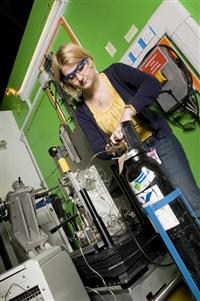A research team led by scientists from the University of Bristol has developed a method for the utilization of carbon dioxide in environmentally friendly and efficient processes for oil extraction

A research team led by scientists from the University of Bristol has developed a method for the utilization of carbon dioxide in environmentally friendly and efficient processes for oil extraction. Soluble additives of carbon dioxide could also be used to reduce the damage to the environment that originates from common industrial processes in the fields of food processing and the electronics sector.
The researchers developed a soap-like additive to the carbon dioxide gas that makes it an important solvent in commercial oil refining thanks to its ability to increase the amount of oil that can be extracted from oil fields.
"Carbon dioxide is useful in increasing the extraction of oil from the ground because it is able to flow between the pores of the rocks more easily than water," said Professor Julian Eastoe from the University of Bristol. "The additive, which is a surfactant, helps to qualify the gas, which is essential for this process, and allows it to flow through the rocks more efficiently. Our ability to use gas in this way also has a positive side effect because in the future the process will be able to utilize carbon dioxide left over from industrial activity that originates in the atmosphere and thus we can lock it deep underground. Extending the duration of exploitation of existing oil sources will also provide scientists with more time for research into the discovery and development of alternative non-carbon-based energy sources, such as solar energy or hydrogen energy."
The use of liquid carbon dioxide is increasingly being used in industry as a substitute for petrochemical solvents since it requires a lower level of processing and since it can be easily reused. The difficulty in this area lies in the fact that in order for the gas to be used as an effective solvent, additives are needed, which in themselves may harm the environment. This study provides the solution to this problem.
"The scientific journey designed to find a chemical that would change the properties of carbon dioxide so that it could be used as a solvent that increases the amount of oil extraction from the ground was a long one," says one of the researchers. "The advances in this field included materials containing fluorine, a material which, despite its high solubility in gas, is very harmful to the environment. The newly developed additive, the surfactant TC14, does not contain fluorine at all and is a hydrocarbon that is not harmful to the environment."
Carbon dioxide gas provides an efficient, inexpensive, non-toxic, non-flammable and environmentally friendly alternative to petrochemical solvents. Even water, in its role as a solvent, has its own problems - after water is used to extract the oil from the soil condensate, it needs to be cleaned before it can be used again for this task, while liquefied carbon dioxide can be reused immediately.
The new additive, a surfactant, enables the formation of tiny pockets, known as reverse micelles, within the liquefied gas, thus making the liquid thicker. Neutron scattering instrumentation allowed the researchers to examine the structure of these reverse micelles in gas during their formation under high-pressure conditions. This equipment, which allows obtaining a point of view at the molecular level, is sometimes described as a "super microscope".
"Neutron beams are able to penetrate deep into the samples and provide unique information about the location and arrangement of the micelles at the molecular level," explains one of the partners in this research.
"By changing the pressure inside an experimental chamber built especially for this purpose, it is possible to easily separate and remove the material dissolved in the sample, leaving only the carbon dioxide for reuse. It would be very difficult to observe this system using other methods because it is necessary to keep the gas under high pressure. Only through the careful examination made possible by the neutron beams can the properties and behavior of the gas be fully discovered."
More of the topic in Hayadan:

2 תגובות
Does the DPF have a liquid accumulation mode?
For those wondering what the hell a micelle is:
http://he.wikipedia.org/wiki/מיצלה